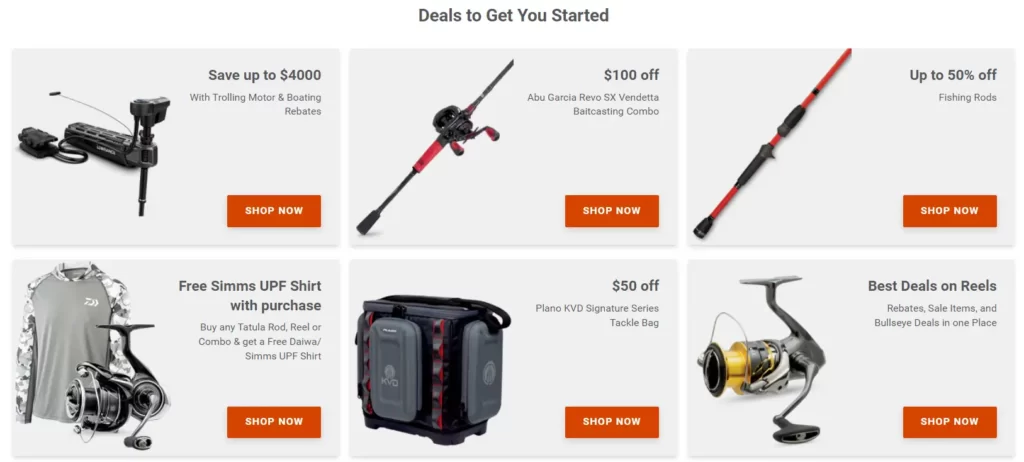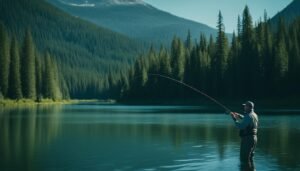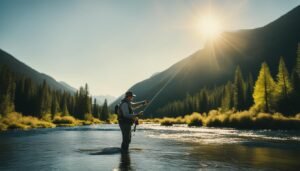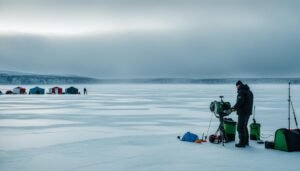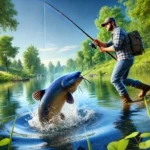Explore Canada's Ultimate Fishing, Hunting, and Wildlife Adventures

River Fishing Guide: Tips and Techniques for Successful Fishing on a River
Welcome to the ultimate guide on river fishing!
As an angler, there’s nothing quite like the thrill of catching fish in a fast-flowing river. However, river fishing can be quite different from other forms of fishing, and it takes some skill and knowledge to be successful. That’s where this guide comes in.
Disclosure: When you purchase a service or a product through our links, we sometimes earn a commission, at no extra cost to you.
Whether you’re a beginner or a seasoned angler, this guide will provide you with all the information you need to unlock the secrets of river fishing and increase your chances of landing a prize catch.
In this guide, we’ll cover everything from the basics of river fishing to the most advanced techniques. We’ll also provide tips on how to find the best river fishing spots, the essential gear and equipment you’ll need, and how to stay safe while fishing in fast-flowing water.
Additionally, we’ll cover the best time of day and year to fish in a river, as well as the necessary regulations and licenses you need to comply with.
Lastly, we’ll address some Frequently Asked Questions about river fishing to provide additional insights and help you get the most out of your fishing experience.
So, whether you’re looking to catch trout, salmon, or other fish species commonly found in rivers, this guide has got you covered.
Key Takeaways
1. River fishing is a unique and challenging experience that requires different techniques and equipment than other types of fishing.
2. Researching the best river fishing spots through local fishing reports, maps, and personal exploration is essential for success.
3. Essential gear for river fishing includes fishing rods, reels, lines, lures, baits, and fishing tackle, along with safety equipment like life jackets.
4. Basic river fishing techniques for beginners include casting, retrieving, and setting the hook, while advanced techniques include drift fishing, nymphing, and fly fishing.
5. Understanding river currents, structures, and the best time for fishing, along with following fishing regulations and practicing proper fish handling and conservation ethics, contribute to a successful river fishing experience.
Disclosure: When you purchase a service or a product through our links, we sometimes earn a commission, at no extra cost to you.
Let’s get started on your journey to becoming a skilled river fisherman!
Understanding River Fishing: An Overview
River fishing is a popular pastime for anglers around the world. It involves fishing in flowing water bodies such as rivers and streams, where fish thrive in a freshwater environment. River fishing requires different techniques and equipment than other types of fishing, making it a unique and challenging experience.
Fly to Your Canadian Fishing Paradise
Book cheap flights to Canada's best fishing spots!
One search, all flights
Find the best deals to your favorite fishing spots
Kiwi.com Guarantee
Travel worry-free with our protection
Trusted by millions
Join anglers booking cheap flights with ease
Disclosure: When you purchase a service or a product through our links, we sometimes earn a commission, at no extra cost to you.
Before embarking on a river fishing adventure, it is essential to understand the basics of this type of fishing, including the gear and techniques used. In this section, we will provide an overview of river fishing, helping you to understand the necessary equipment and techniques required to catch fish in a river.
Understanding the Gear Required for River Fishing
The gear required for river fishing depends on various factors such as the type of fish you are targeting, your level of expertise, and the location.
However, some essential equipment for river fishing includes a fishing rod, reel, line, lures, and baits. Anglers can choose from a range of specialized river fishing gear, such as waders, boots, and vests, to keep themselves safe and comfortable while fishing in the water.
Mastering River Fishing Techniques
River fishing techniques require a unique set of skills and patience.
The key is to understand the behavior of the fish, the water currents, and the structure of the river. Some of the essential techniques include casting, retrieving, and setting the hook. Experienced anglers can also try their hand at advanced techniques such as drift fishing, nymphing, and fly fishing.
Choosing the Right River Fishing Spot
Finding the right fishing spot is crucial for a successful river fishing experience. Some of the best river fishing spots may remain hidden from plain sight, and anglers need to do their research to identify these locations. Factors such as river depth, water temperature, and the presence of underwater structures can all influence where fish are likely to be located.
In the next section, we will provide tips on researching the best river fishing spots and the techniques to use when fishing in a river.
Researching the Best River Fishing Spots
Locating the best river fishing spots can be challenging, especially for beginners. However, with the right tools and knowledge, finding prime fishing locations can be much more straightforward.
Here are some tips to help you get started:
1. Research Local Fishing Reports
Local fishing reports can be a valuable resource to find information on the best river fishing spots. These reports are usually created by professional anglers or local fishing communities and provide updated information on the latest fishing conditions and hotspots in the area. You can find these reports by searching online, talking to local anglers or visiting local fishing stores.
2. Check Local Fishing Maps
Another excellent way to find the best fishing spots is by checking local fishing maps. These maps are usually provided by state wildlife agencies or fishing organizations and show the location of all the local rivers, lakes, and streams. They also provide information on the type of fish found in each location, the best time to fish, and other helpful tips.
3. Explore the River Yourself
One of the most effective ways to locate the best fishing spots is by exploring the river yourself. By walking the riverbanks, you can get a better sense of the river’s flow and structure, which can help you identify prime fishing locations. Look for natural structures like rocks, logs, and underwater vegetation that attract fish and try different techniques in these areas to see what works best.
4. Ask Local Guides or Charter Services
If you’re new to river fishing, it can be beneficial to hire a local guide or charter service for a day. These professionals have a wealth of knowledge and experience in river fishing and can help you locate the best fishing spots, provide advice on which equipment to use and techniques to try, and teach you how to read the river’s currents and structures.
By following these tips, you’ll be better equipped to find the best river fishing spots in your local area and increase your chances of success. Remember to always respect fishing regulations and be mindful of the environment, so future generations can enjoy the sport of river fishing as well.
Essential River Fishing Gear and Equipment
Having the right gear and equipment is crucial for successful river fishing.
Here’s a breakdown of the essential tools you’ll need:
| Item | Description |
|---|---|
| Rod and reel | Choose a rod and reel that is appropriate for the size of the fish you’re targeting and the type of fishing you’ll be doing. |
| Fishing line | Select a fishing line that matches the weight of your rod and reel and is suitable for the type of fishing you’ll be doing (e.g., monofilament, fluorocarbon, braided). |
| Fishing lures | Various types of lures are available, including spinners, spoons, jigs, and crankbaits. Choose lures that mimic the natural prey of the fish you’re targeting. |
| Fishing baits | Bait options include live bait (such as worms or minnows) and artificial bait (such as PowerBait or Gulp! baits). |
| Fishing tackle | Essential tackle items include hooks, sinkers, swivels, and leaders. Choose sizes and styles that are suitable for the fish species you’re targeting and the fishing conditions you’ll be facing. |
| Fishing net | A net will help you safely land and release your catch. |
| Fishing vest or pack | Carry all of your gear and supplies in a fishing vest or pack for easy access on the water. |
In addition to the items listed above, consider bringing along polarized sunglasses to reduce glare on the water and a hat to protect your face from the sun. A wading staff can also be helpful for stability when wading in the river.
Basic River Fishing Techniques for Beginners
If you are new to river fishing, it’s essential to learn several basic techniques to help you get started. These techniques will help you catch more fish and provide a solid foundation for more advanced methods.
Casting
The casting technique is a fundamental skill to learn when river fishing. To cast, hold your rod with both hands, keeping your elbows close to your body. Point the rod towards your desired location and pull the rod back to around 10 o’clock. Next, smoothly and swiftly flick your wrist forward, releasing the line. The rod’s power and flexibility will transfer the energy to the lure or bait, helping it land in your chosen spot.
Retrieving
Retrieving is the process of reeling in your line after you have cast it. The technique you use to retrieve depends on the type of lure or bait you are using. However, a general rule is to reel in your line smoothly and steadily, avoiding any sudden jerks that may scare the fish away. It’s also essential to keep an eye on the tip of your rod to detect any bites as you reel in your line.
Setting the Hook
Setting the hook means pulling the rod firmly to set the hook into the fish’s mouth after they have bitten your bait or lure. It’s crucial to wait for the fish to take the bait and start swimming away before setting the hook. Once they have taken the bait, reel in the slack line until you feel the weight of the fish, and then pull the rod in a swift motion to set the hook.
By mastering these three basic river fishing techniques, you’ll be ready to catch your first fish and move on to more advanced techniques. Remember, practice makes perfect, so get out on the water and start fishing!
Advanced River Fishing Techniques for Seasoned Anglers
If you have already mastered the basics of river fishing and are looking for a new challenge, it’s time to explore more advanced techniques. These techniques require more skill and patience, but can lead to bigger and more rewarding catches.
Here are some of the most effective advanced river fishing techniques:
Drift Fishing
Drift fishing involves using a floating bait or lure, allowing it to drift naturally downstream with the current. This technique requires precise control over the drift, using mends and line management to adjust the speed and direction of the bait or lure. It is particularly effective for catching trout and steelhead in rivers.
Nymphing
Nymphing is a technique that involves using an artificial fly that imitates the immature form of aquatic insects, known as nymphs. The fly is cast upstream and allowed to drift naturally downstream, with the angler using the rod to control the speed and direction of the fly. It is a popular technique for catching trout and other species that feed on aquatic insects.
Fly Fishing
Fly fishing is a technique that involves using a specialized rod, reel, and line to cast a lightweight artificial fly. The angler must use skill and precision to cast the fly accurately and delicately, mimicking the natural movements of insects and other prey. Fly fishing can be a challenging but rewarding way to catch a variety of river fish.
Remember, these advanced techniques require more skill and practice than basic river fishing methods. Take the time to develop your technique and learn from experienced anglers. With practice and patience, you can become a master of advanced river fishing techniques.
Reading the River: Understanding Currents and Structures
When it comes to river fishing, understanding the currents and structures of the river is essential to locating where fish are likely to be found. The following tips will help you identify these important factors.
Types of Currents
River currents can be classified into three types: slow, moderate, and fast. Slow currents are characterized by a gentle flow and are typically found in shallow parts of the river. Moderate currents are more powerful and can be found in deeper parts of the river. Fast currents are the strongest and are often found in the center of the river channel.
Structures of the River
The structures of the river are also important to consider when trying to locate fish. Structures can include rocks, logs, deep holes, and anything else that can provide shelter and protection for fish. These structures can be found both in the center of the river and along the banks.
How to Identify Prime Fishing Spots
When looking for prime fishing spots, start by identifying areas with moderate currents and structures such as rocks and logs. These structures can provide shelter and protection for fish, making them more likely to be found in these areas. Additionally, look for areas with gravel or rocky bottoms, as these areas can also be prime feeding grounds for fish.
By understanding the currents and structures of the river, you can significantly increase your chances of catching fish and having a successful river fishing experience.
River Fishing Safety Precautions
While river fishing can be an enjoyable and rewarding experience, it’s important to take the necessary safety precautions to prevent accidents and injuries. By following these guidelines, you can ensure a safe and successful river fishing trip:
Wear a Life Jacket
When fishing in or around water, it’s crucial to wear a properly fitted life jacket. Even the most experienced swimmers can get into trouble in unexpected situations, such as strong currents or sudden storms. A life jacket can help keep you afloat and prevent drowning.
Be Aware of Potential Hazards
Before you start fishing, take a few minutes to survey your surroundings and identify any potential hazards. Look out for slippery rocks, deep holes, fast-moving currents, and any dangerous wildlife in the area. Avoid fishing near dams or other structures where water can be unpredictable and dangerous.
Use Proper Equipment
To avoid accidents and injuries, it’s important to use the right gear and equipment for river fishing. Choose a rod and reel combination that is appropriate for the type of fish you’re targeting and the size of the river you’re fishing in. Make sure your tackle is in good condition and properly rigged to avoid any equipment malfunctions.
Stay Alert
When fishing in a fast-moving river, it’s important to stay alert and aware of your surroundings. Keep an eye on the water’s current and be prepared to move quickly if necessary. Keep an eye out for other anglers in the area and be respectful of their space.
Dress Appropriately
When river fishing, it’s important to dress appropriately for the weather and conditions. Wear breathable clothing that will keep you comfortable and dry, even if you get wet. Avoid wearing heavy or bulky clothing that can impede your movement.
Bring Safety Supplies
Before heading out on a river fishing trip, make sure to bring some basic safety supplies, such as a first aid kit, a whistle, and a flashlight. These items can help you in case of an emergency and ensure a safe and successful fishing trip.
Top River Fishing Tips and Tricks
If you’re looking to take your river fishing to the next level, there are plenty of tips and tricks you can use to increase your chances of success.
Here are some top river fishing tips and tricks to consider:
- Try different bait and lures: Sometimes, fish are not attracted to the first bait and lures you use. Experiment with different types and colors to find what works best for the specific river and fish you are targeting.
- Use polarized sunglasses: Polarized sunglasses can help you see through the water’s glare and spot fish more easily.
- Pay attention to the weather: The weather can greatly impact fish behavior. Check the forecast before heading out and adjust your strategy accordingly.
- Be patient: River fishing often requires patience. Don’t give up if you don’t get a bite right away. Try changing your technique and keep trying.
- Pay attention to your line: Your line can provide valuable information about fish activity. Keep an eye on your line for any movement or sudden changes in tension.
- Stay low: When approaching the river, stay low and avoid making loud noises. Fish can be easily spooked and may swim away if they sense danger.
- Fish during low light periods: Fish are more active during low light periods, such as early morning or late evening. Plan your fishing trip accordingly.
- Clean your gear: Always clean your gear after each fishing trip to prevent the spread of invasive species and to ensure your equipment remains in good condition.
- Learn from others: Don’t be afraid to ask other anglers for advice or tips. You may learn something new that can greatly improve your river fishing experience.
The Best Time for River Fishing
While river fishing can be enjoyed year-round, some seasons and time frames are more productive than others. Understanding the optimal times for river fishing can increase your chances of catching fish and make your overall experience more enjoyable.
Typically, the best time for river fishing is during the spring and fall seasons when the water temperature is cooler and fish are more active. During the summer, fish tend to move to deeper waters to escape the heat, making them more difficult to catch. During the winter, fish become less active and may be more challenging to locate.
It is also important to consider the time of day for river fishing. Early morning and late evening tend to be the most productive times as fish are more active during these periods. However, fishing during the middle of the day can also be successful, particularly if the weather is overcast or rainy.
Factors to Consider
When deciding the best time for river fishing, it is essential to consider weather patterns and fish behavior. Rainy days can often be advantageous for fishing, as the water becomes more turbid, making it more difficult for fish to see. Similarly, cloudy days can cause fish to move to shallower waters, making them more accessible to anglers. Additionally, it is necessary to take into account the type of fish you are targeting and their preferred habitats and behaviors.
Overall, understanding the best time for river fishing can help increase your chances of success and make your experience more enjoyable. However, it is essential always to be mindful of fishing regulations and ethical practices, ensuring the sustainability and conservation of fish populations and their habitats.
River Fishing Regulations and Licenses
Before engaging in river fishing, it’s crucial to understand and comply with the applicable laws and regulations. Fishing regulations vary depending on the location and the species of fish you’re targeting, so it’s essential to research the specific rules and restrictions that govern the area you plan to fish in.
You may need to obtain a fishing license to legally fish in certain rivers or bodies of water, and the type of permit required can differ depending on the state or country you’re in.
In the US, for example, the Department of Fish and Wildlife regulates fishing licenses on a state-by-state basis and requires anglers to possess a valid permit. It’s important to note that fishing without a license can result in significant penalties, so make sure you have the appropriate credentials before casting your line.

What are some common regulations for river fishing?
Regulations for river fishing can vary depending on the location, but some common restrictions include:
| Regulation | Description |
|---|---|
| Catch and release only | Anglers may be required to release all fish caught back into the water to preserve the fish population, particularly for endangered species. |
| Size limits | Some bodies of water enforce size limits, meaning that fish below a certain size must be released to allow them to grow and reproduce. |
| Bag limits | Anglers may be limited to a certain number of fish that they can catch and keep in a day to prevent overfishing and depletion of the fish population. |
It’s important to comply with these regulations and restrictions to protect the environment and ensure that the river’s ecosystems and fish populations remain healthy and sustainable for future generations of anglers.
Proper Fish Handling and Conservation Ethics
When it comes to river fishing, it’s not just about catching fish. It’s essential to also practice proper fish handling and conservation ethics to ensure the long-term health and sustainability of fish populations and their habitats. Here are some key things to keep in mind:
Handling Fish
When handling fish, it’s important to use wet hands or gloves to avoid damaging their delicate skin. Avoid squeezing the fish too tightly, as this can cause internal damage. If the fish has swallowed the hook, cut the line as close to the hook as possible to minimize harm.
If you plan to release the fish, minimize its time out of the water. Hold it gently in the water until it regains its strength and swims away on its own. If the fish is bleeding or appears injured, consider keeping it for consumption to avoid wasting the valuable resource.
Conservation Ethics
As an angler, it’s important to respect and protect the environment in which you fish. Always carry out any trash or litter you bring in and avoid damaging vegetation or disturbing wildlife.
When selecting bait and lures, consider using options that are environmentally friendly and do not harm the fish or their habitat. Practice catch and release whenever possible and avoid exceeding the limits set by local regulations and restrictions.
Fishing Regulations
Before heading out to fish in a river, make sure you are aware of the fishing regulations and licenses required in that area. These regulations are in place to protect the ecosystem and preserve fish populations for future generations to enjoy. Always follow these regulations and encourage others to do the same.
By practicing proper fish handling and conservation ethics, you can enjoy river fishing while also contributing to the preservation of the environment and its inhabitants. Remember, every little effort counts.
River Fishing Mistakes to Avoid
While river fishing can be a rewarding experience, there are several common mistakes that anglers should avoid to increase their chances of success:
- Not researching the fishing spot: Before heading out, it’s crucial to research the river you plan on fishing in, as well as the specific area you’ll be targeting. Knowing the water conditions, fish species, and feeding habits can greatly improve your chances of success.
- Using the wrong gear: Different fishing techniques require different gear and equipment. Ensure that you have the appropriate gear for the technique you’ll be using, and that it’s in good condition.
- Not paying attention to the weather: Weather conditions can greatly affect fish behavior, so it’s important to check the forecast before heading out. Fishing during a cold front or low-pressure system can make for a difficult day on the water.
- Not practicing proper catch and release: If you plan on releasing the fish you catch, it’s important to handle them properly to ensure their survival. Avoid damaging their gills or removing their protective slime coat.
- Not being patient: Fishing requires patience and persistence. It can take hours or even days to catch the fish you’re after, so it’s important to be patient and persistent.
“Avoiding these common mistakes can help make your experience on the water more enjoyable and increase your chances of catching fish.”
Tips for Catch and Release in River Fishing
Catch and release is an important practice for preserving fish populations and habitats in river ecosystems. To ensure the fish’s survival after being caught, here are some guidelines and tips for catch and release practices in river fishing:
- Use appropriate gear: Use gear that is suitable for the size and type of fish you are targeting to reduce the chance of injury or stress to the fish. Avoid using barbed hooks, as they can cause more damage to the fish’s mouth and make it more difficult to release them.
- Handle fish with care: When handling fish, wet your hands or use a wet cloth to prevent removing their protective slime coating. Avoid squeezing or putting excessive pressure on the fish’s body or gills. Use needle-nose pliers or a dehooking tool to remove hooks, and release the fish quickly.
- Revive fish properly: If the fish appears tired or stressed after being caught, hold it upright in the water and gently move it back and forth to promote oxygen flow through its gills. Keep the fish in the water until it can swim away on its own.
- Stay aware of water temperature: When the water temperature is high, the oxygen levels in the water decrease, making it harder for fish to recover from the stress of being caught. Avoid fishing during the hottest part of the day or in water temperatures above 68°F.
- Choose appropriate release locations: Avoid releasing fish in shallow or stagnant water, as they may be more vulnerable to predators or have difficulty recovering. Instead, release the fish in deeper, faster-moving water where they can regain their strength.
Remember, the goal of catch and release is to ensure that the fish survive to fight another day. By following these guidelines and treating the fish with care, you can help maintain healthy fish populations and ecosystems for future generations of anglers to enjoy.
FAQ about about River Fishing
What is river fishing?
A: River fishing is a type of angling that takes place in flowing water bodies such as rivers, streams, and creeks. It involves using various fishing techniques and equipment to catch different species of fish that reside in these water bodies.
What types of fish can be caught in rivers?
A: A variety of fish species can be caught in rivers, depending on the location and season. Common types of fish caught while river fishing include trout, salmon, bass, catfish, and walleye.
What is the best time for river fishing?
A: The best time for river fishing depends on several factors such as the type of fish you are targeting and the weather conditions. Generally, early morning and late afternoon are good times to fish, and certain seasons may be better for certain species of fish.
Can I fish in any river?
A: No, it is important to research the river you intend to fish in and ensure that you have the necessary permits and licenses. Some rivers may be protected or closed for fishing during certain times of the year, and breaking these regulations can result in fines or other penalties.
What gear and equipment do I need for river fishing?
A: The essential gear for river fishing includes a fishing rod, reel, line, hooks, bait or lures, and tackle. Other useful equipment may include a landing net, waders, and polarized sunglasses.
What are some common river fishing techniques?
A: Some common techniques for river fishing include casting, drifting, and fly fishing. Advanced techniques such as nymphing and spey casting are also used by experienced anglers.
How do I stay safe while river fishing?
A: It is important to wear a life jacket and be aware of potential hazards such as strong currents, deep pools, and slippery rocks. It is also advisable to fish with a partner and let someone know your location and expected return time.
Can I practice catch and release in river fishing?
A: Yes, catch and release is a common practice in river fishing. It involves catching a fish and then immediately releasing it back into the water unharmed. Proper catch and release techniques can help ensure the survival of the fish.
What are some common mistakes to avoid in river fishing?
A: Some common mistakes to avoid in river fishing include using the wrong gear or bait, not reading the water correctly, and not practicing proper fish handling techniques. It is also important to respect the environment and other anglers around you.
Resources and External Links
Here are some additional resources and external links that can help you learn more about “River Fishing”:
Articles:
- How to Go River Fishing: The Complete Guide – FishingBooker
- A Beginner’s Guide to River Fishing – Lines on the Water
- Georgia River Fishing – Bass Blog
- Columbia River mainstem, tributary fishing summary for July 10-16 – The Columbian
YouTube Videos:
- SOLO Bridge Fishing for River Walleye (New Truck Update!) – Samong Outdoors
- River Fishing for Trout, Bass & Sunfish – Fish Hawk
- These HUGE BOULDERS Hold BIG FISH!! (Shallow River Fishing) – Spencer – River Certified
These resources provide additional information and insights about “River Fishing”.


